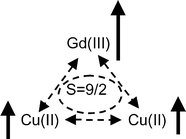Hetero di- and trinuclear Cu–Gd complexes with trifluoroacetate bridges: synthesis, structural and magnetic studies†
Abstract
The synthesis, structural determinations and magnetic properties of an original dinuclear Cu–Gd and two trinuclear Cu–Ln–Cu complexes (Ln = Gd or Dy) made with a


 Please wait while we load your content...
Please wait while we load your content...